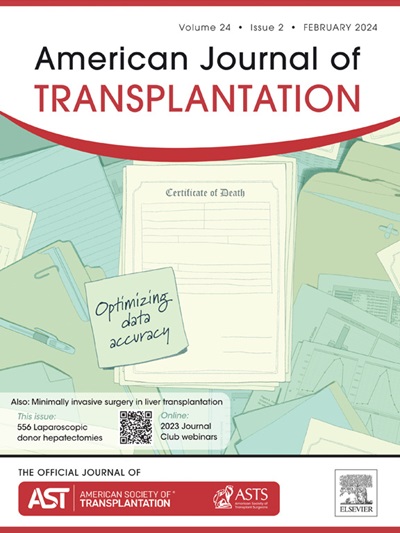杆子的短端:在复合分配评分时代,矮个子患者获得肺移植的途径。
IF 8.2
2区 医学
Q1 SURGERY
引用次数: 0
摘要
矮小的肺移植(LTx)候选者比高个子的候选者等待时间更长。新的综合分配分数(CAS)包括高度,以提高分配的公平性。我们评估了CAS对不同身高组候补名单结果的影响。我们在国家移植数据库中查询了2021年至2024年的LTx候选者,将其分为四个身高组:≤162 cm, 162-170 cm, 170-176.5 cm, bb0 176.5 cm。竞争风险和Cox回归模型评估了身高对候补名单结果的影响,包括身高和分配时代之间的相互作用项,以评估效果的修改。在确定的9383例候选患者中,与170-176.5 cm组相比,bb0 176.5 cm组移植的可能性增加(sHR 1.15),而≤162 cm组的可能性较低(sHR 0.70)。在CAS时代,移植的总体可能性更高(sHR 1.17);身高≤162 cm与CAS年龄的交互作用项显著(sHR为1.15),表明CAS对该群体的可及性有一定改善。此外,在CAS时代,≤162 cm的候选患者的死亡率更高(HR 1.60)。这些发现表明,CAS适度地改善了最短候选人群的可及性,但需要改进以解决这一人群中持续存在的不平等问题。本文章由计算机程序翻译,如有差异,请以英文原文为准。
The short end of the stick: Access to lung transplantation for short-statured patients in the composite allocation score era
Short-statured lung transplant candidates experience longer waitlist times than taller ones. The new composite allocation score (CAS) includes height to enhance allocation equity. We assessed the impact of CAS on waitlist outcomes for different height groups. We queried a national transplant database for lung transplant candidates listed from 2021 to 2024, categorized into 4 height groups: ≤162 cm, 162 to 170 cm, 170 to 176.5 cm, and >176.5 cm. Competing risk and Cox regression models assessed the impact of height on waitlist outcomes, including an interaction term between height and allocation era to assess effect modification. Of the 9383 candidates identified, those >176.5 cm had an increased likelihood of transplantation (subdistribution hazard ratio [sHR]: 1.15) compared to the 170 to 176.5 cm group, while those ≤162 cm had a lower likelihood (sHR: 0.70). The overall likelihood of transplantation was higher in the CAS era (sHR: 1.17). The interaction term for height ≤162 cm and CAS era was significant (sHR: 1.15), suggesting a modest improvement in access for this group under CAS. Further, candidates ≤162 cm experienced a higher hazard of mortality in the CAS era (HR: 1.60). These findings suggest that CAS modestly improves access for the shortest candidates, but refinements are needed to address ongoing inequities in this population.
求助全文
通过发布文献求助,成功后即可免费获取论文全文。
去求助
来源期刊
CiteScore
18.70
自引率
4.50%
发文量
346
审稿时长
26 days
期刊介绍:
The American Journal of Transplantation is a leading journal in the field of transplantation. It serves as a forum for debate and reassessment, an agent of change, and a major platform for promoting understanding, improving results, and advancing science. Published monthly, it provides an essential resource for researchers and clinicians worldwide.
The journal publishes original articles, case reports, invited reviews, letters to the editor, critical reviews, news features, consensus documents, and guidelines over 12 issues a year. It covers all major subject areas in transplantation, including thoracic (heart, lung), abdominal (kidney, liver, pancreas, islets), tissue and stem cell transplantation, organ and tissue donation and preservation, tissue injury, repair, inflammation, and aging, histocompatibility, drugs and pharmacology, graft survival, and prevention of graft dysfunction and failure. It also explores ethical and social issues in the field.

 求助内容:
求助内容: 应助结果提醒方式:
应助结果提醒方式:


